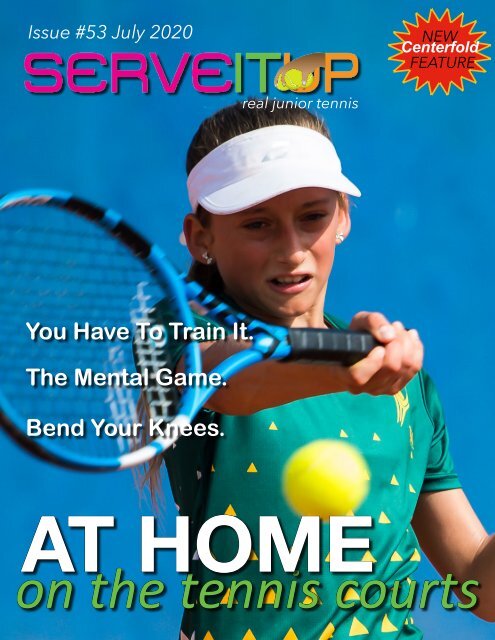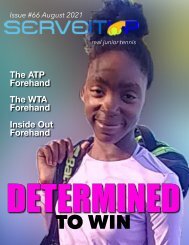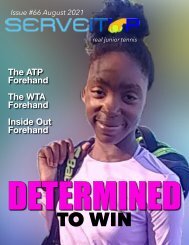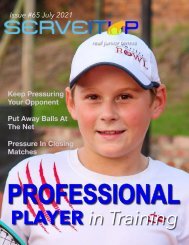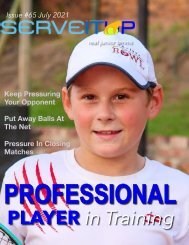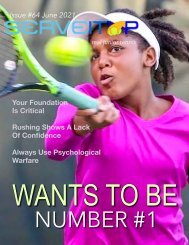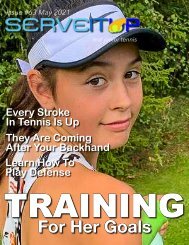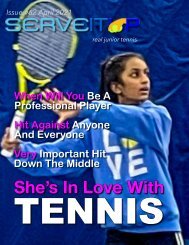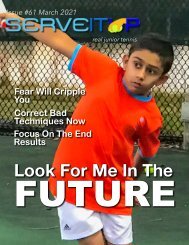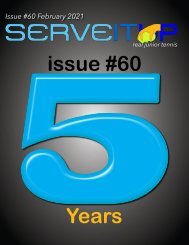Serveitup Tennis Magazine #53
the only monthly digital junior tennis magazine
the only monthly digital junior tennis magazine
Create successful ePaper yourself
Turn your PDF publications into a flip-book with our unique Google optimized e-Paper software.
Issue <strong>#53</strong> July 2020<br />
NEW<br />
Centerfold<br />
FEATURE<br />
real junior tennis<br />
You Have To Train It.<br />
The Mental Game.<br />
Bend Your Knees.<br />
AT HOME<br />
on the tennis courts<br />
<strong>Serveitup</strong> August 2019 1
<strong>Tennis</strong> Talk<br />
Disclaimer<br />
<strong>Serveitup</strong> <strong>Tennis</strong> <strong>Magazine</strong> does not warrant or assume any legal<br />
liability or responsibility for the quality, accuracy, completeness, legality,<br />
reliability or usefulness of any information, product or service<br />
represented within our magazine or web site. The information provided<br />
is for educational or entertainment purposes only.<br />
Anyone using the information provided by <strong>Serveitup</strong> <strong>Tennis</strong> <strong>Magazine</strong>,<br />
whether medical, legal, business or other, does so at their<br />
own risk, and by using such information agrees to indemnify <strong>Serveitup</strong><br />
<strong>Tennis</strong> <strong>Magazine</strong> from any and all liability, loss, injury, damages,<br />
costs and expenses (including legal fees and expenses) arising<br />
from such use.<br />
<strong>Serveitup</strong> <strong>Tennis</strong> <strong>Magazine</strong> does not endorse or recommend any article,<br />
product, service or information found within said articles. The<br />
views and opinions of the authors who have submitted articles to<br />
<strong>Serveitup</strong> <strong>Tennis</strong> <strong>Magazine</strong> belong to them alone and do not necessarily<br />
reflect the views of <strong>Serveitup</strong> <strong>Tennis</strong> <strong>Magazine</strong> or its staff.<br />
Links to other web sites from <strong>Serveitup</strong> <strong>Tennis</strong> <strong>Magazine</strong> or its website<br />
are provided for convenience only. <strong>Serveitup</strong> <strong>Tennis</strong> <strong>Magazine</strong><br />
is not responsible for the content or availability of any external or<br />
3rd party sites and does not warrant or guarantee the products, services,<br />
or information found on these sites.<br />
2 <strong>Serveitup</strong> August 2019
PUBLISHERS DESK<br />
06/15/20<br />
wesley@serveituptennismagazine.com<br />
All articles are written by the publisher<br />
Wesley Baptiste unless otherwise noted.<br />
“work the ‘rust‘ off”<br />
Players across the globe can’t wait to get back unto the courts. Some players<br />
have already gotten back, some players are just getting back, and some still<br />
have to wait a little while longer.<br />
What is constant, is, every player no matter their level, will have to work the<br />
‘rust‘ off their game, and get back into tennis shape, before they can compete<br />
at the highest level.<br />
One of the first things they are going to have to regain, is their timing. It’s one<br />
of the things that you think is alright, but even though your mind tells you that<br />
you are ready, your eyes will need time to teach your body how to react and<br />
adjust properly, biomechanically. So be patient, it will come back.<br />
Subscribe at serveituptennismagazine.com, to get a new issue in your inbox<br />
every month.Tell us what you think! Follow, and leave a comment on Facebook,<br />
YouTube, Twitter and Instagram, or email info@serveituptennismagazine.com<br />
P.S. Don’t forget to share us.<br />
Enjoy!
Our Credo<br />
<strong>Serveitup</strong> is the quintessential junior tennis magazine. We intend<br />
to promote and showcase only junior tennis players 18 and under.<br />
<strong>Serveitup</strong> lays claim to the fact that we are real junior tennis.<br />
<strong>Serveitup</strong> is the most unique, dynamic, cutting-edge junior tennis<br />
publication on the planet. Our vision at <strong>Serveitup</strong>, is to transport<br />
you every month, on an exciting journey into the remarkable lives<br />
of real junior tennis players. We will tell their stories and reveal<br />
who they are. You will know about their Lifestyles, Fashion, Tournaments,<br />
Health & Fitness, Achievements, Equipment, Instructions,<br />
Goals, Passions, Training Methods, Travel and much more, before<br />
they become the next tennis superstars.<br />
We will strive for excellence in every issue. Every publication will<br />
be specifically designed to deliver the most relevant resources to<br />
educate, motivate, empower, showcase and interact with all junior<br />
tennis players. We will chronicle the lives of the junior players, as<br />
they begin their pursuit into that elite world of tennis stardom.<br />
For this reason <strong>Serveitup</strong> is totally free and 100% juniors. We will<br />
promote junior tennis players, whether they play the junior circuit<br />
or the pro level. We intend to affect junior tennis globally by getting<br />
<strong>Serveitup</strong> into the hands of current and future junior tennis<br />
players. That makes <strong>Serveitup</strong> a must read for every player... and<br />
their parents? So get all your photos and content ready, and send<br />
them to info@serveituptennismagazine.com
July 2020<br />
in this issue <strong>#53</strong><br />
6<br />
Handicaps Will Improve<br />
Your Game.<br />
30<br />
Centerfold.<br />
8<br />
You Have To Train<br />
It.<br />
32<br />
Keep A Competitive<br />
Mind.<br />
12<br />
The Mental Game.<br />
34<br />
We Repeat Athlete<br />
First.<br />
18<br />
Bend Your Knees.<br />
36<br />
Practice Against The<br />
Wall.<br />
20<br />
22<br />
Motivation Needs<br />
Inspiration.<br />
Cover Story: Who Is<br />
Mari-Louise Van Zyl<br />
38 Footwork.<br />
22<br />
Cover Story<br />
Who Is Mari-Louise Van Zyl
Handicap<br />
WILL IMPROV<br />
YOUR GAM<br />
TREMENDOUS
Most junior tennis players, simply refuse<br />
to hit against someone who they think<br />
is way beneath their level. That is a big<br />
mistake.<br />
Playing with someone beneath your level,<br />
gives you the ideal opportunity, to<br />
work on shots and strategies you need<br />
to perfect, in a non threatening way.<br />
A player beneath your level will tolerate<br />
all your mistakes, and be excited and motivated<br />
to run down any ball you hit out<br />
of their strike zone.<br />
s<br />
E<br />
E<br />
LY<br />
It even gets challenging for you. Play a<br />
match against them, and give them a<br />
handicap... like 30points on every game.<br />
You will begin to instantly notice that, you<br />
will feel a lot of pressure.<br />
If you lose, don’t just pass it off as you<br />
gave them points. Treat it as a serious<br />
loss, and play them again and again, until<br />
you can completely dominate them.<br />
Then give them 40, and do the same<br />
thing, all over again.
You have to<br />
TRAIN<br />
it
You can have all the speed in the world,<br />
and still be moving incorrectly and late<br />
to the ball on the court. World class<br />
footwork requires that you train your<br />
movement specifically. Remember that<br />
fitness is not footwork. You have to train<br />
for better footwork.
onCourt<br />
with<br />
Mari-Louise Van Zyl<br />
Instagram: @tennis_marilouise
onCourt<br />
with<br />
Samuel Rayner<br />
Instagram: @sartennis04
BARCELONA TENNIS ACADEMY<br />
MENTAL<br />
THE<br />
game
The psychology of tennis comprises a<br />
vast variety of skills that players need<br />
to master in order to perform to their<br />
optimal potential and lift their mental<br />
game to the next level. One of the<br />
tasks that our tennis academy puts a<br />
special emphasis is on instilling into<br />
our players the on-court habit of relying<br />
on routines. More specifically,<br />
we want our players to have at their<br />
disposal pre-game routines, a set of<br />
match routines as well as post-match<br />
ones. Altogether, routines build players’<br />
mental game which is a combination<br />
of actions, thoughts and self-talk<br />
sequences helping them to isolate<br />
themselves from the outside world,<br />
effectively manage energy levels and<br />
maintain point-by-point focus.<br />
The start point of this endeavour is<br />
the development of various performance<br />
focus plans functioning as<br />
mental checklists - things to do at every<br />
stage of the game. The next step<br />
is their over-learning through daily<br />
practice of mental effort. The idea<br />
behind it is that when players have a<br />
plan for what to do and what to think<br />
about during each part of the game,<br />
not only does it help them to tune out<br />
all types of distractions, but, most of<br />
all, it prompts the right focus on task<br />
relevant cues automatically. Routines<br />
as a tool enable them to stay absorbed<br />
in the activity. As a consequence, they<br />
may lose themselves in their familiarity<br />
and execute their shots with feel<br />
and automaticity.<br />
The building blocks of routines customarily<br />
consist of triggers and cue<br />
words aligned together to form fixed<br />
sequences of actions.<br />
When Rafael Nadal arranges his bottles<br />
on the court invariably at the same<br />
tilted angle in the midst of all the commotion<br />
accompanying a match play,<br />
it acts as a spatial type of trigger separating<br />
his own personal space, the<br />
zone of competing, from the rest of<br />
the world with all its noise and chaos.<br />
He subjects the surroundings to<br />
match his preferred mental-scape, to<br />
sustain his internal order and impose<br />
it on the outside space. He builds a<br />
wall around himself, a special type of<br />
setting where you’re shielded from<br />
any negative influence from the outside.<br />
On the psychological plane, this enhanced<br />
narrow focus relies on the<br />
use of triggers, an array of your own<br />
special movements, gestures, words,<br />
images which set off this perspective<br />
switch from your daily type of focus<br />
to performance focus marked by intense<br />
concentration and prolonged<br />
alertness.
Players also need to find cue<br />
words or phrases reminding<br />
them what to think about,<br />
what to do, orient you to the<br />
process during practice or a<br />
match.<br />
For example, “see the ball,<br />
hear the ball”; “just look at<br />
the ball”, “don’t let the ball<br />
drop”, “bounce-hit”. All the<br />
triggers and cue words relevant<br />
and helpful for a given<br />
player should be combined<br />
to form plans for every part<br />
of the game. Then, they can<br />
work as fixed scenarios of patterned<br />
actions, which with<br />
time function as habits.<br />
We like to divide the between-point<br />
time of 25 seconds<br />
into four steps:<br />
1) Neutral reaction - what<br />
happened?<br />
2) Routines - mind is blank<br />
focusing on the present (racquet<br />
strings, towel, etc.)<br />
3) Preparation for next point<br />
(strategy)<br />
4) Routines - bouncing ball<br />
before serve, etc.<br />
The first step is analytical and<br />
preferably without any signs<br />
of emotion.<br />
The second is mostly dedicated<br />
to fast forgetting of what<br />
has just happened. This is the<br />
moment for the player to rely<br />
on a mix of triggers to erase<br />
the previous point from their<br />
memory as quickly as possible.<br />
The third one again is about<br />
planning out the strategy for<br />
the next point.<br />
In the last one, the player<br />
employs a set of preparation<br />
routines to get themselves<br />
ready and focused.<br />
Serena Williams’ between-point<br />
sequence alternates<br />
between the following<br />
steps: she turns her back to<br />
the opponent with her eyes<br />
frequently on the racket<br />
strings and her head down.<br />
Depending on the situation,<br />
she calms herself down either<br />
by shaking her hand with the<br />
palm down or closing her eyes<br />
and taking a deep breath. Alternatively,<br />
she taps her thigh<br />
to pump herself u<br />
she faces the net ag<br />
to execute another<br />
Such mental per<br />
plans help athletes k<br />
minds focused on t<br />
ty, on the act to be<br />
They accomplish th<br />
task through the sk<br />
forgetting or leavin<br />
a point that has just<br />
This idea of quick<br />
has also its paralle<br />
of Maria Sharapo<br />
tween-point routin<br />
may serve as a re<br />
pensing with anyth<br />
It consists of two b<br />
of reaction and refo<br />
In the first stage,<br />
her back on the o<br />
and faces the wall t<br />
after the mistake or<br />
mind after the prev<br />
winner or error.<br />
The goal is to stay o<br />
keel no matter the<br />
stances.
p. Finally,<br />
ain ready<br />
point.<br />
formance<br />
eep their<br />
he actividone.<br />
is difficult<br />
ill of fast<br />
g behind<br />
finished.<br />
forgetting<br />
l in one<br />
va’s bees,<br />
which<br />
lease dising<br />
past.<br />
asic steps<br />
cus.<br />
she turns<br />
pponent<br />
o regroup<br />
clear her<br />
ious shot,<br />
n an even<br />
circum-
Next, she turns to face the net again and<br />
moves on to ‘readying’ – starting to focus<br />
on the immediate task ahead of her<br />
with a clean state of mind.<br />
Some tennis players add to this sequence<br />
the ‘reflect’ component by quickly revising<br />
what was wrong and how to improve<br />
it, which is frequently accompanied by<br />
the shadowing of the correct shot execution.<br />
The key thing is to shut yourself<br />
from the moment that has just passed<br />
by turning away and then to open yourself<br />
up for the present by turning back<br />
again.<br />
After dealing with the point that is over,<br />
another task for the player is fast mental<br />
preparation for the next shot to be<br />
played. For this crucial stage players need<br />
to have another set of triggers and cues<br />
helping them to quickly move from one<br />
stage of the game to another, without<br />
wasting excessive time on the past and<br />
approach a new task with a fresh mind<br />
and full readiness.<br />
In her pre-serve routine, Sharapova<br />
heavily relies on eye control, which facilitates<br />
triggering intense concentration<br />
and keeping distractions out of the field<br />
of focus. She focuses her eyes in select<br />
points of the court. She looks down at<br />
the racket, up at the other service box<br />
and her target point, then back down as<br />
she bounces the ball and then she rolls<br />
them back when raising the racket to<br />
crack a serve.<br />
The idea is to plan ahead what to look<br />
at and when already involved in the process,<br />
guide the ball with the eyes. Focusing<br />
on a precise target brings a narrow,<br />
external concentration that enhances<br />
performance. It is a case of selective type<br />
of attention where only singled out information<br />
is being attended to while the<br />
rest is effectively screened out.<br />
It is our strong belief that players should<br />
work on their mental games day in day<br />
out and train their minds for optimal oncourt<br />
performance and self-control. Developing<br />
mental focus plans and turning<br />
them into pre-performance, performance<br />
and post-performance routines<br />
is one of our main priorities in our daily<br />
work with our players.<br />
Our objective in this regard is for players<br />
to operate on a point-by-point basis regardless<br />
of the outcome. Thanks to this<br />
rigorous state of mind, which can only<br />
be achieved through the consistent implementation<br />
of routines, they will be<br />
able to sustain their on-task attention,<br />
accomplish mental steadiness and generate<br />
internal rhythm, which are all staples<br />
for maintaining optimal concentration<br />
in performance.
BEND<br />
YOUR<br />
KNEES
This is one of the worst piece of advice<br />
that has been passed on to junior tennis<br />
players. You never see pro players bending<br />
their knees in order to hit a ball. Yet<br />
coaches everywhere are telling juniors<br />
to bend their knees. Instead of teaching<br />
them how to load properly.
Even though they say they want it, most<br />
junior players are not motivated to put in<br />
the hard work that is needed, to fulfil their<br />
dreams. It is normally the parent or coach<br />
who has to continually push them. But if<br />
they get inspired by an idol or another<br />
junior player who they admire, and that<br />
player makes it, then that motivates them<br />
to work harder, to pursue their dreams.<br />
MOTIVATION<br />
INSPIRATION<br />
Needs
My name is Mari-Louise<br />
van Zyl. I am 14 years old<br />
and I was born in South Africa.<br />
My tennis journey began<br />
when I was 6 years old.<br />
I started having a few lessons<br />
a week at our school<br />
on one of the 2 cracked<br />
tennis courts, and my dad<br />
would always hit with us<br />
when we have free time in<br />
our hands.<br />
From the beginning I loved<br />
it and never wanted to leave<br />
the court! I also played other<br />
sports like hockey, netball<br />
and athletics. I enjoyed<br />
it, but my favorite time of<br />
the day would either be to<br />
be playing tennis or watching<br />
how the pro’s play on TV<br />
and imagine myself playing<br />
amongst them one day.<br />
Mar<br />
VA
Cover Story<br />
From South Africa with Love<br />
Instagram:<br />
@tennis_marilouise<br />
i-Louise<br />
N ZYL
As I grew older my mom<br />
and dad saw that I have<br />
the potential to become<br />
a professional. My family<br />
didn’t really play tennis, although<br />
everybody loved<br />
watching it. We were more<br />
into athletics.<br />
Once or twice a month we<br />
went to a tennis academy<br />
for the weekend, to train<br />
with other good players<br />
I didn’t get the golden trophy.<br />
I only got to practice<br />
about twice a week and<br />
on the weekends. I started<br />
to love the winning<br />
more and had to learn<br />
how to accept losing although<br />
I hated it! I made<br />
quite a few friends during<br />
the tournament and just<br />
loved the vibe and all the<br />
adrenaline.<br />
and top coaches. I had a<br />
lot of fun and played a few<br />
local mini tournaments.<br />
I am determined to work<br />
hard and reach my goal;<br />
that is to win Wimbledon<br />
and become number 1 in<br />
the world.<br />
When I was 10 years old<br />
I had my first great result<br />
and came 2nd at the u/10<br />
South African Nationals. I<br />
was happy to make it so<br />
far, but disappointed that
Later on we started training<br />
harder and by age 12,<br />
I was representing South<br />
Africa around Africa and<br />
competed in a lot of different<br />
tournaments. We<br />
also moved to a different<br />
town, so my sisters and I<br />
can be at a better tennis<br />
academy, where I can play<br />
against a lot of different<br />
players.<br />
Later on in my u/12 year I<br />
was privileged to get my<br />
first sponsor by babolat.<br />
That was the best feeling<br />
ever and when my rackets<br />
and clothing arrived I was<br />
even more motivated to<br />
reach my goal.<br />
I started traveling a lot<br />
to tennis tournaments<br />
and had a lot of ups and<br />
downs, but overall I had<br />
great results. My play<br />
started getting better and<br />
better, both mentally and<br />
physically. I also started<br />
training with a conditioning<br />
coach to help me prevent<br />
my injuries, as well as<br />
training more hours. I still<br />
go to normal school but I<br />
train in the early mornings<br />
and afternoons, 6 days a<br />
week.
During my u/14 year I got a<br />
clothing sponsor by lotto!<br />
It was really a special moment.<br />
It came just after I<br />
at a field. I take breaks often<br />
after big tournaments<br />
so that I can work on recovery.<br />
played overseas for South<br />
Africa with some amazing<br />
results. I also played my<br />
first 2 ITF tournaments. It<br />
was quite a different ball<br />
game against older players<br />
but I learned a lot.<br />
During this lockdown period<br />
that is caused by this<br />
awful virus, I’m having fitness<br />
or hitting some tennis<br />
balls in our garden. I also<br />
now have a lot more time<br />
I am so glad to have an<br />
awesome supporting system<br />
from my family, coaches<br />
and trainers who always<br />
wants the best for me.<br />
They make many sacrifices<br />
to get ahead on schoolwork<br />
and work on things<br />
that I don’t normally have<br />
time to do. You have to<br />
make the most of what<br />
you’ve got, to get to the<br />
top.<br />
for me and my 2 younger<br />
sisters, so that we can become<br />
the best we can be.<br />
We always work together<br />
and help each other. My<br />
training still takes place at<br />
our tennis academy that<br />
has beautiful hard courts.<br />
I have fitness in a gym or
I will keep working, training<br />
and doing whatever<br />
it takes to reach my goal<br />
and have a healthy happy<br />
life.<br />
I love reading or spending<br />
time with my family<br />
during my free time. One<br />
of my favorite activities<br />
is to play a sibling doubles<br />
match. Just having<br />
fun and laughing makes<br />
life so much better, especially<br />
on the tennis court.<br />
That is where my home is.<br />
I still do running and enjoy<br />
it a lot. It is lots of fun<br />
to go on morning jogs<br />
with my sisters.
NEW<br />
Centerfold<br />
FEATURE
Ciara
keep a<br />
COMPETITIV<br />
min
The moment you step unto the court,<br />
you need to be ready to compete. A<br />
surgeon, singer, pilot, boxer or some<br />
other profession, don’t get to ‘warmup‘<br />
and make mistakes first before<br />
they get it right. You need to be competitive<br />
from the instant you step on<br />
the court.<br />
E d
It doesn’t matter if you have all the tennis<br />
skills in the world. It will not turn you<br />
into a top junior or professional player.<br />
The thing that will push you over the<br />
top, is becoming an athlete. Become<br />
an athlete first, and you will definitely<br />
be on your way to becoming a top<br />
world class professional player.
we repeat!!!<br />
ATHLETE<br />
FIRST
PRACTICE<br />
AGAINST<br />
THE WALL
There is nothing like practicing<br />
against a wall. It gives you the most<br />
intense workout, and is great for<br />
working and fixing your strokes. If<br />
you know how, you can work on every<br />
stroke against the wall.
Fitness<br />
footwork!<br />
your first option...<br />
get to the ball!
Artist: Cat Lee<br />
follow her on instagram @colacatlee<br />
let’s play tennis, call it, heads or tails!
visit our new<br />
WEBSITE<br />
serveituptennismagazine.com


